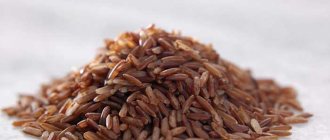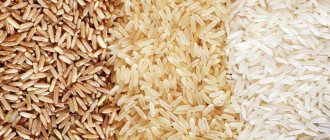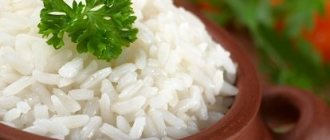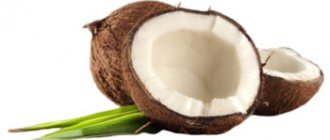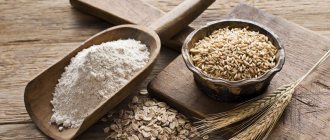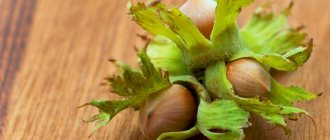Basmati and jasmine, white and brown, long-grain and short-grain - stores offer us a wide range of rice, the variety of which is easy to get lost in. Which variety is best for porridge, and which should be left for pilaf? What is the difference between sushi rice? And, most importantly, which rice is the healthiest?
We are accustomed to considering this cereal a valuable source of complex carbohydrates, but is it really useful? Is rice recommended for everyone? Increasingly they say that it has a high glycemic index and it is worth reducing its consumption. To understand all these issues, we turned to gastroenterologists, nutritionists and nutritionists.
Nutrients of rice
Rice has many beneficial properties. We'll talk about this below:
- Rice is one of the main sources of several B vitamins: thiamine B1, riboflavin B2, niacin B3 and B6; vitamin PP, carotene, vitamin E. They help improve the nervous system and have a positive effect on the condition of nails, skin and hair.
- This product contains complex carbohydrates, making this product nutritious and low in calories.
- It has a positive effect on weight loss.
- Also, one of the positive aspects of the product is that it contains 8 amino acids. They are necessary for the human body to create new cells.
- Rice grains consist of 9% protein.
- Also worth noting is the fact that rice, unlike other grains, contains absolutely no gluten. Gluten is a plant protein that causes allergic reactions.
- Contains lecithin. It is a popular brain booster, an oligosaccharide that helps repair the gut, and gamma-aminobutyric acid that helps normalize blood pressure.
- This product contains a large amount of potassium. It helps neutralize the effects of salt on the body, which enters the body with other foods.
- This healthy product also contains small amounts of phosphorus, zinc, iron, calcium and iodine.
- Note that quite a lot of nutritionists recommend arranging fasting days on a rice diet. But the most important thing is to be careful. You also need to know how much to use this product. The fact is that it contains sodium in small quantities. Sodium does not release water from the body.
- Rice, especially brown rice, contains a huge range of active substances. It is thanks to such substances that it can be called the best means for removing toxins and excess fluid from the body.
- Rice contains a huge amount of essential vitamins, minerals and trace elements.
- By the way, half of rice consists of starch. Starch is easily digestible and is considered the best source of energy.
- This product contains few calories and many ballast substances that stimulate the digestive system.
Rice is a great option for those who want to lose weight. To get rid of excess weight, we recommend giving preference to brown, unrefined rice. The thing is that such a product is the best solution for getting rid of toxins in the body.
However, this does not mean that you need to give up white refined rice. It can also be consumed, but it is recommended to do it occasionally and for variety.
To preserve its beneficial properties, we recommend consuming it without salt. After all, salt has a negative effect, it binds water and does not release it from the body. That is why it is very important to avoid adding salt. It is also recommended to drink liquid in large quantities.
It is recommended to drink at least two liters of water daily. We also recommend drinking several mugs of herbal teas. In particular, you should pay attention to nettle tea, tea based on birch and juniper leaves. Such varieties have an effect on the removal of toxins and excess fluid from the body.
The amount of its nutrients depends on how much processing the rice grain has undergone. We recommend buying rice from well-known manufacturers and paying attention to what kind of processing it has undergone. After all, during processing it loses its beneficial properties.
What varieties are there?
Most Popular:
- Basmati. Otherwise known as Thai rice, it has a delicate nutty flavor and a pleasant texture. It is considered the world king in the market, as it is the most in demand. Its grains are the longest, so basmati is considered an elite variety. Its plantations are located near the Himalayas - there is the most suitable climate.
- Jasmine. It also holds the record for grain length. The variety received this name for its exquisite, weak, but pleasant aroma of fresh milk, which is somewhat reminiscent of the aroma of jasmine. It has an excellent taste and a soft, non-stick structure. This rice is cultivated on plantations in Southeast Asia (Thailand, Vietnam). Alternative name: aromatic. Jasmine is more moist and sticky when compared to basmati, but does not boil or lose its shape.
- Wild. It grows only in North America, under the protection of the Great Lakes. The properties of this variety are among the most revered. It has a slightly sweet, pleasant taste, a faint nutty aroma, and is rich in everything that rice can be rich in - dietary fiber, vitamins, folic acid, part of the periodic table. Its grains are distinguished by their length and dark, thick shade - dark brown, close to black grains are smooth and almost cast reflections. The main feature of wild rice is its high protein content. This variety contains several times more organic matter than all others. This is why wild rice is one of the most expensive grains on the grain market, in particular because of its uniqueness and exclusivity. For cooking, it is mixed with white varieties - this is what tradition dictates.
- Arborio. Arborio grains are medium-sized, not very long, slightly transparent. This variety is grown on Italian plantations and is included in many Italian national dishes. It is beneficial to add it to risotto and paella (alternatives to our pilaf), and to soups. There the cereal acquires a delicate texture, similar to cream, pleasant in taste and smell.
How does rice work for weight loss?
When losing weight, simple and affordable rice will be especially useful. However, we note that it is often not used when losing excess weight. This is very in vain, because this product helps to cleanse the body and, most importantly, it contains all the important useful components.
Ordinary and affordable rice can provide invaluable benefits in the fight for a slim figure, although it is usually not customary to use the product when losing weight, but in vain. Cereal perfectly cleanses the body and contains necessary and beneficial components.
Proper use of such a product in the fight for an ideal figure includes:
- limited time period (using such a diet for a long time is very undesirable, because rice is known for its ability to cause a calcium deficiency in the body);
- compliance with restrictions (pregnant and lactating women, children, people suffering from gastritis and peptic ulcers).
Note that to obtain a good result, it is not the type of rice that matters, but the rate at which it is consumed.
To properly prepare dietary rice, we recommend rinsing it with cold water in the evening and leaving it overnight. In the morning, drain the water and prepare it using your usual method. Note that rice cooked in water is the best helper for those who are losing weight.
Effect of the rice diet
Of course, for those who want to lose excess weight, before going on a rice diet, you need to find out about the results of such a diet:
- Rice is a very healthy product for those who are losing weight. The most important benefit of rice is that it helps cleanse the body of toxins. Along with cleansing, your state of health also improves.
- To start a long and serious diet, we recommend starting with a small deload. The rice diet will help you here.
- If you are trying to lose weight on rice, then such weight loss has a long-lasting effect. To consolidate the results obtained, we recommend not consuming “heavy” foods for the next 10 days, this applies to fatty and salty foods.
- The rice diet always gives quick and visible results. In just 7 days of the rice diet you can get rid of 6 kg.
Cellulose
Brown rice contains a significant amount of fiber (1.8%), while white rice contains virtually no fiber (0.3%). One bowl of cooked brown rice (195 grams) contains approximately 3.5 grams of fiber.
Various amounts of resistant starch are also found in both white and brown rice. Resistant starch helps feed beneficial bacteria in the gut, stimulating their growth.
In the colon, resistant starch leads to the formation of short-chain fatty acids such as butyric acid, which may improve gut health and reduce the risk of colon cancer (, ,).
In addition to resistant starch, fiber is concentrated in the bran that is removed from white rice. Bran is primarily composed of insoluble dietary fiber, such as hemicellulose, and contains virtually no soluble fiber.
Summary:
White rice contains virtually no fiber, while brown rice is a good source. Both types may also contain varying amounts of resistant starch, which may promote colon health.
Diet dishes with rice
Below we have selected a couple of recipes for dietary dishes with rice for you.
Diet rice with chicken
To prepare you will need:
- Chicken fillet - 450 gr.
- Rice - 180 gr.
- Water - two glasses.
- Onion - 1 pc.
- Carrots - 1 pc.
- Vegetables - 60 gr.
- Greens - 3 gr.
So, let's move on to the cooking process:
- Shred the chicken and place in the slow cooker.
- Place rice.
- Pour in water.
- Finely chop the onion and add to the slow cooker.
- Grate the carrots and add to the rest of the ingredients.
- Mix the contents of the multicooker well.
- Set the pilaf mode for 50 minutes.
- Garnish with herbs and serve the dish.
Cook without salt or oil!
Harm and contraindications
The harm from eating rice dishes is almost minimal. Avoiding grains is recommended for people with:
- individual intolerance to the product;
- high blood sugar;
- weak intestinal activity;
- regular constipation (there is a possibility of cracks and hemorrhoids).
- Due to the high starch content, it can bring extra pounds. To make the product dietary, rice should be soaked in water and then rinsed.
If you are diagnosed with diabetes, brown rice varieties are recommended. The male contingent should exclude the systematic consumption of rice porridge from the diet. The presented product reduces sexual activity. Therefore, you should not exceed the consumption of cereals, the norm is 2 – 3 times a week.
Comparing the calorie content of dishes
| Diet rice with chicken | Diet rice with vegetables and shrimp |
| Nutritional value per 100 g: Calories: 102 kcal. Proteins: 11 gr. Fats: 0.7 gr. Carbohydrates: 14.2 g. | Nutritional value per 100 g: Calories: 86 kcal. Proteins: 6 gr. Fats: 0.4 gr. Carbohydrates: 16 gr. |
Summarize
- Rice is a popular grain crop around the world, especially in Asia.
- White rice is the most commonly eaten rice, but brown rice is becoming more common due to its significantly healthier options.
- Thanks to several beneficial minerals and antioxidants, brown rice may help prevent the development of cardiovascular disease.
On the other hand, high consumption of white rice (especially glutinous rice) is associated with an increased risk of developing type 2 diabetes.
The article was prepared by experts for informational purposes only. It should not be used as a guide for treating medical conditions and is not a substitute for professional medical advice, diagnosis, or treatment. In case of illness or any symptoms, you should always consult a doctor and not self-medicate.
Tags: rice
About the author: Alexander Fedorov
Candidate of Biological Sciences, biologist, nutrition expert. Graduated from Stavropol State University with a degree in Biology at the Faculty of Biology and Chemistry.
- Related Posts
- Bulgur: what kind of grain is it, how to cook, calorie content
- What is the difference between bleached and unbleached flour?
- Lowest Carb Cereals: 8 Best Options
« Previous entry
What is rice water?
At first I was confused about what exactly rice water was.
When our family makes rice, there is no water left because we use a rice cooker. I asked a friend who does it the old fashioned way (in a pot of boiling water) and her rice absorbs all the water. When I looked into it a little more, the water actually comes from the washing process before cooking. We rinse the rice 2 – 3 times before cooking it as this prevents the rice from mating while cooking and improves the taste. That milky liquid we've always been throwing down the drain is actually the good stuff we're talking about here.
You can dilute, concentrate, or even ferment this water, depending on your personal preference. I will explain all the possible ways to use it later.
What's happened
First of all, what is it and why is it useful? Rice water (sometimes called kanji) is a cloudy liquid made by soaking rice for a period of time.
Some rice water is fermented. This means it sits longer and produces certain beneficial compounds, like all fermented substances.
Rice (Oryza sativa) is a grain that contains a number of nutrients. When rice is soaked, some of it is released into the liquid. Then it is useful to apply the milk to the head and skin.
What's happened
First of all, what is it and why is it useful? Rice water (sometimes called kanji) is a cloudy liquid made by soaking rice for a period of time.
Some rice water is fermented. This means it sits longer and produces certain beneficial compounds, like all fermented substances.
Rice (Oryza sativa) is a grain that contains a number of nutrients. When rice is soaked, some of it is released into the liquid. Then it is useful to apply the milk to the head and skin.
The secret of ancient Asian women
Eastern women at all times could boast of their luxurious braids. How did they look after them? Finally their secret is revealed! Their remedy for growth, nutrition, and strengthening of hair is ordinary rice water, which many housewives pour out after cooking rice.
Chinese women did the opposite with it, they used it to wash and rinse their hair. The result of this care is braids up to 2 meters long and as thick as an arm. They had never even heard of gray hair. This result was included in the Guinness Book of Records.
The benefits of rice water have been proven for centuries. Back in 800 AD. The women of the Japanese imperial court used a rice recipe.
Women secretly passed on their secrets from mouth to mouth. But in the age of the Internet, this has ceased to be a secret.
Useful properties of the decoction:
- The composition of the healing decoction includes a whole list of minerals and vitamins.
- The carbohydrate inositol, which remains on the hair even after rinsing, repairs any damage.
- Amino acids strengthen roots, increase volume, restore shine and silkiness.
When cooking rice, you get white water, similar to liquid milk - this is a healing decoction. It not only works wonders on hair, but also perfectly tightens the skin of the face, making it elastic and smooth.
